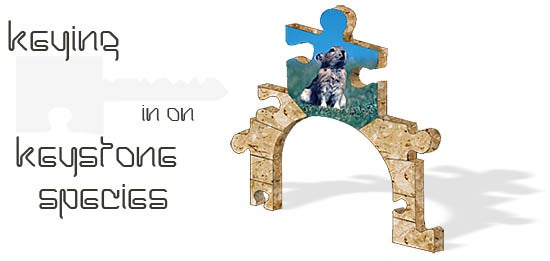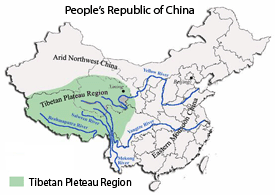
Illustrated by: Dr. Biology

When Professor Andrew Smith looks at his favorite study animal, he sees more than a cute furry mammal. To him the Plateau Pika has helped to explain the importance of even the smallest animals and their impact on the plants and animals that live in their communities.
Plateau Pikas are one of the 30 species of pika worldwide. All 30 species of pika are similar in appearance. They look like round balls of fluff about 6 inches long with prominent round ears and a small tail hidden under their fur. Plateau Pikas live on the mountain plateaus in China, 11,000-14,000 feet above sea level.
Dr. Smith is a conservation biologist at ASU, and much of his effort is concentrated on studying Plateau Pikas on the high Tibetan plateau grasslands in central China. His work in China is helping to save a keystone species.
What's a Keystone Species?
 What is a keystone species and why are they special? A keystone species is critical for the survival of other species in its community. If a keystone species is driven to extinction it is likely that other species will also disappear. Many animals depend on these keystone species for food, or other benefits that aid in their survival.
What is a keystone species and why are they special? A keystone species is critical for the survival of other species in its community. If a keystone species is driven to extinction it is likely that other species will also disappear. Many animals depend on these keystone species for food, or other benefits that aid in their survival.
Misunderstood animals
Pikas have been considered by some in China to be pests. There have been widespread attempts to wipe out the pika population through poisoning programs. But Dr. Smith's research revealed that there is something unique about the way pikas interact with the other species in their environment.
Importance of Pikas
Pikas dig burrows in the high alpine meadows where they live. These burrows provide protection from predators, a place to raise young, and shelter from the cold. High on these meadows there are no trees and very little shelter of any kind. Pika burrows become important to other animals. Most of the birds that live in this area use pika burrows for nests. Without them the birds would have no safe places to roost or raise young. Pikas also are the primary food source for birds of prey and carnivorous mammals such as weasels, foxes, wolves, and bears. If the pikas disappear, these animals will lose a valuable food source that they depend on for survival.
These are some of the factors that led Dr. Smith to claim that the pika is a keystone species. Dr. Smith's research has been important in helping scientific organizations in China to realize the value of the pikas to their ecosystem. Dr. Smith's research is one example of how scientists can make a difference and help protect species that may be in danger.
He works closely with the International Union for the Conservation of Nature (IUCN). One of the primary goals of IUCN is to keep an inventory of the status of plant and animal species that may be in danger of extinction, now or in the future. This inventory is known as the "Red List."
Scientists around the world work with IUCN to build and maintain the Red List. As they study a species, they check the status of several important factors.
How do species get on the Red List? Here are some of the questions scientists are asking when evaluating a species.
- What is the size of the population?
- How fast is it declining?
- How big of an area does this species live in?
- How has its habitat been affected?
When they have the answers to these and other questions, then the species is ready to be "Red-listed". It is placed into one of nine categories on the Red List, depending on the present and future expected threat to the species.
IUCN relies upon scientists like Dr. Smith to provide the organization with valuable data and recommendations. This close working relationship between IUCN and scientists allows the Red List to reflect the current status of species that may be in danger. Governments and environmental organizations around the world can use the Red List to help them make decisions about conservation priorities and habitat protection. The overall goal is to raise awareness and provide information that can help the global community to reduce species extinctions.
Additional Information on the Red List can be found at https://www.redlist.org/.
Read more about: Keying in on Keystone Species
Bibliographic details:
- Article: Keying in on Keystone Species
- Author(s): Tracy Johns
- Publisher: temp
- Site name: ASU - Ask A Biologist
- Date published:
- Date accessed:
- Link: https://askabiologist.asu.edu/explore/keying-keystone-species
APA Style
Tracy Johns. (). Keying in on Keystone Species. ASU - Ask A Biologist. Retrieved from https://askabiologist.asu.edu/explore/keying-keystone-species
Chicago Manual of Style
Tracy Johns. "Keying in on Keystone Species". ASU - Ask A Biologist. . https://askabiologist.asu.edu/explore/keying-keystone-species
Tracy Johns. "Keying in on Keystone Species". ASU - Ask A Biologist. . ASU - Ask A Biologist, Web. https://askabiologist.asu.edu/explore/keying-keystone-species
MLA 2017 Style

Andrew Smith with a young panda friend.
Be Part of
Ask A Biologist
By volunteering, or simply sending us feedback on the site. Scientists, teachers, writers, illustrators, and translators are all important to the program. If you are interested in helping with the website we have a Volunteers page to get the process started.


